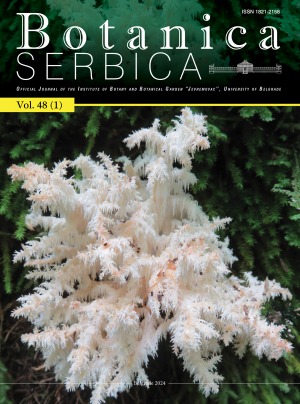
Volume 48 Issue 1 2024 |
Red-list of liverwort and hornwort species of Serbia: 2024 assessment
|
KEY WORDS: threat assessment, conservation, bryophyte, extinction risk. |
Phenolic profile and antimicrobial activity of leaf extracts from five Artemisia species (Asteraceae)
|
KEY WORDS: antibacterial activity, antifungal activity, flavonoids, phenolic acids |
Biological activities of Liquidambar orientalis: antibiofilm, cytotoxicity, apoptosis, and miRNA expressions
|
KEY WORDS: antibiofilm activity, A549 cells, cytotoxicity, Liquidambar orientalis, microRNA. |
Current distribution, trends, abiotic and biotic preferences of two Elodea species in Bulgaria
|
KEY WORDS: Elodea canadensis, Elodea nuttallii, invasive alien species. |
Dynamic changes in rhizosphere bacterial communities of Rhododendron simsii at different growth stages
|
KEY WORDS: bacterial populations, community structure, high-throughput sequencing, rhizosphere, Rhododendron species |
The phytocoenology, distribution, and habitat preferences of the species Aldrovanda vesiculosa (Droseraceae) in Romania
|
KEY WORDS: habitat characteristics, phytocoenology, recent distribution, translocation, waterwheel. |
Vegetation affinity of Epipactis albensis (Orchidaceae) in Central Europe
|
KEY WORDS: autogamous orchid, Czech Republic, Epipactis, floodplain and beech forests, orchids, Poland, Slovakia |
First records of two genera and 20 species of fungi (Basidiomycota, Agaricales) in Montenegro
|
KEY WORDS: basidiomycetes, biodiversity, biogeography |
European endemic Ptychostomum minii (Bryaceae, Bryophyta) - new to Turkey and its significant range extention to SW Asia
|
KEY WORDS: Bolkar Mountains, Bryophytes, endemic, mosses, new record, Turkey |
Chara squamosa (Characeae, Charophyceae) in Serbia - insights from the taxonomic revision of the BEOU charophyte collection and recent field records
|
KEY WORDS: Charophytes, Chara gymnophylla, Chara squamosa, distribution, stoneworts, the Balkans |
New records and noteworthy data of plants, algae and fungi in SE Europe and adjacent regions, 16
|
KEY WORDS: new report, Anacamptis × nicodemi, Androsace lactea, Bangia atropurpurea, Buxbaumia aphylla, Didymella vitalbina, Discostella asterocostata, Drosera rotundifolia, Epipogium aphyllum, Epipactis palustris, Gymnadenia frivaldii, Phragmotrichum rivoclarinum, Potentilla montenegrina, Sphagnum divinum, Stephanodiscus hantzschii f. tenuis, Tortella fasciculata, Tozzia alpina subsp. carpathica, Ulva pilifera, SE Europe |
New records and noteworthy data of plants, algae and fungi in SE Europe and adjacent regions, 17
|
KEY WORDS: new report, Acaulon triquetrum, Buxbaumia aphylla, Clinopodium vardarense, Dicranum viride, Entyloma gaillardianum, Epipactis palustris, Helichrysum doerfleri, Hericium coralloides, Hericium flagellum, Juglanconis juglandina, Micarea lignaria var. lignaria, Opopanax chironium subsp. bulgaricum, Pertusaria flavicans, Placidiopsis custnani, Rosellinia corticium, Sauteria alpina, Stegocintractia luzulae, SE Europe |
Waterlogging affects the anti-melanogenic properties of Platycodon grandiflorus roots
|
KEY WORDS: anti-melanogenic property, Platycodon grandifloras, triterpenoid saponins, waterlogging |
List of reviewers for Botanica Serbica in 2023 — Acknowledgements
|


